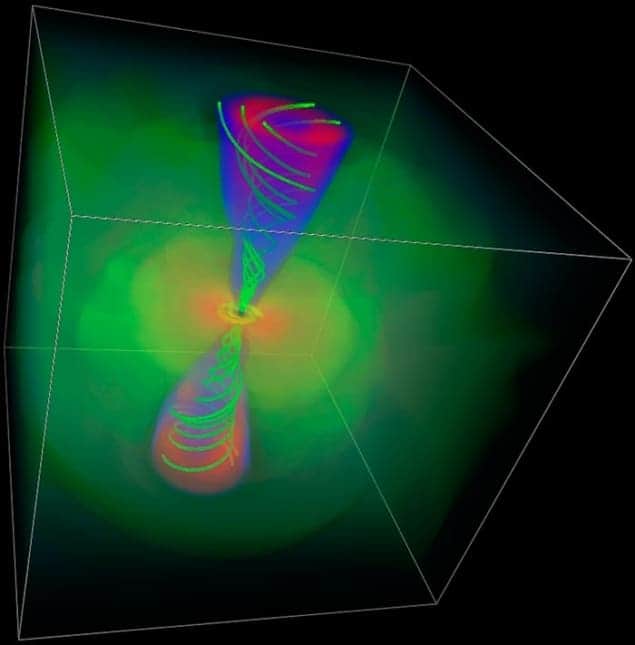
Matter ejected from a supermassive black hole travels several light years before being accelerated to nearly the speed of light. This is the surprising conclusion of an international team of astronomers who used the Fermi Gamma-ray Space Telescope to study radiation from a blazar – a supermassive black hole that fires an intense beam of radiation directly at Earth. The result is at odds with some theories that suggest the acceleration occurs much nearer to the black hole.
Up to a billion times heavier than the Sun, supermassive black holes are mind-boggling entities that dominate the centre of most large galaxies. Many are surrounded by a thin “accretion disc” of matter that swirls into the black hole like water going down a drain. Near the centre of the disc, the matter is so hot that atoms are stripped of electrons to create a rotating plasma that generates huge magnetic fields.
In some supermassive black holes the magnetic field lines pop out of either side of the disk like uncoiling springs, taking jets of matter with them (see figure). If one of the jets happens to point towards Earth, astronomers see a “blazar” – literally, a blaze of radiation at energies all the way up to the highest detectable gamma rays. The radiation is focused into a tight beam by a process called relativistic beaming, which means that it is created in a region of the jet that has been accelerated to about 95% of the speed of light.
Flaring blazar
But exactly what drives this acceleration to near light speed – and exactly where it occurs along the length of the jet – has long been a mystery. Now, however, the Fermi astronomers, and colleagues using several other ground- and space-based instruments, have an answer after studying a 20-day increase in the intensity of gamma rays emitted by blazar 3C 279. They also measured how the polarization of visible light changed during this flare – visible light is polarized because it is produced by electrons orbiting the magnetic field lines in the jets.
They spotted a big change in polarization, which they think occurs as a huge “blob” of ejected material encounters a bend in the jet located at least 10,000 black-hole-radii away – roughly 10 light-years – from the black hole itself. As this polarization rotation occurred exactly at the same time as the flare itself, they conclude that the flare must also be produced by the blob of ejected material. The blazar was therefore produced at a distance that is up to a thousand times further from the centre of the hole than had been predicted by some models.
Concerted coordination of telescopes
Andy Young, an astrophysicist at the University of Bristol in the UK says that the work in an example of what can achieved when astronomers make “a concerted effort to coordinate various observatories”. Young, who was not involved in the 3C 279 analysis, told physicsworld.com that Fermi is currently monitoring a number of different blazars so astronomers can combine observations from a number of flares.
One important goal of such studies is to gain a better understanding of how supermassive black holes grow by accreting matter. Not all black holes eject matter in jets, and understanding why jets occur could provide important insights into the evolution of galaxies and galaxy clusters. This is because the jets are so powerful that they can heat up the gas in vast areas of space, which appears to affect how galaxies grow.
The work is reported in Nature 463 919.



